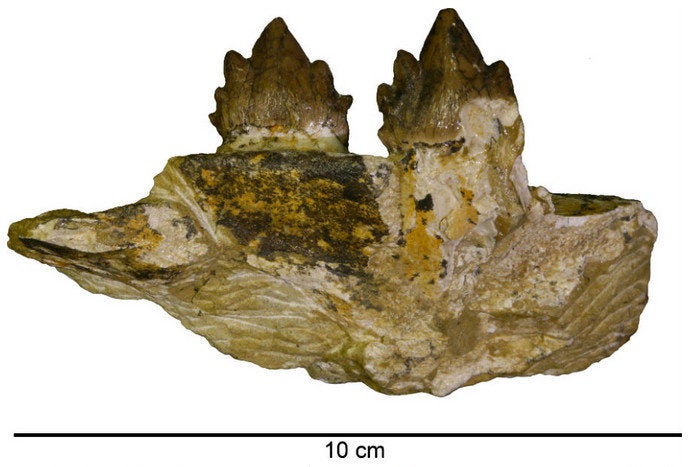
By Carolyn Gramling
BOSTON—Chalk yet another fossil find up to roadcut science. Thanks to a highway-widening project in California’s Laguna Canyon, scientists have identified several new species of early toothed baleen whales. Paleontologist Meredith Rivin of the John D. Cooper Archaeological and Paleontological Center in Fullerton, California, presented the finds here today at the annual meeting of AAAS (which publishes ScienceNOW).
“In California, you need a paleontologist and an archaeologist on-site” during such projects, Rivin says. That was fortuitous: The Laguna Canyon outcrop, excavated between 2000 and 2005, turned out to be a treasure trove containing hundreds of marine mammals that lived 17 million to 19 million years ago. It included 30 cetacean skulls as well as an abundance of other ocean dwellers such as sharks, says Rivin, who studies the fossil record of toothed baleen whales. Among those finds, she says, were four newly identified species of toothed baleen whale—a type of whale that scientists thought had gone extinct 5 million years earlier.
Whales, the general term for the order Cetacea, comprise two suborders: Odontoceti, or toothed whales, which includes echolocators like dolphins, porpoises, and killer whales; and Mysticeti, or baleen whales, the filter-feeding giants of the deep such as blue whales and humpback whales.The two suborders share a common ancestor.
Mysticeti comes from the Greek for mustache, a reference to the baleen that hangs down from their jaw. But the earliest baleen whales actually had teeth (although they’re still called mysticetes). Those toothy remnants still appear in modern fin whale fetuses, which start to develop teeth in the womb that are later reabsorbed before the enamel actually forms.
The four new toothed baleen whale species were also four huge surprises, Rivin says. The new fossils date to 17 to 19 million years ago, or the early-mid Miocene epoch, making them the youngest known toothed whales. Three of the fossils belong to the genus Morawanocetus, which is familiar to paleontologists studying whale fossils from Japan, but hadn’t been seen before in California. These three, along with the fourth new species, which is of a different genus, represent the last known occurrence of aetiocetes, a family of mysticetes that coexisted with early baleen whales. Thus, they aren’t ancestral to any of the living whales, but they could represent transitional steps on the way tothe toothless mysticetes.
The fourth new species—dubbed “Willy”—has its own surprises, Rivin says. Although modern baleen whales are giants, that’s a fairly recent development (in the last 10 million years). But Willy was considerably bigger than the three Morawanocetus fossils. Its teeth were also surprisingly worn—and based on the pattern of wear as well as the other fossils found in the Laguna Canyon deposit, Rivin says, that may be because Willy’s favorite diet may have been sharks. Modern offshore killer whales, who also enjoy a meal of sharks, tend to have similar patterns of wear in their teeth due to the sharks’ rough skin.
The new fossils are a potentially exciting find, says paleobiologist Nick Pyenson of the Smithsonian Institution’s National Museum of Natural History. Although it’s not yet clear what Rivin’s team has got and what the fossils will reveal about early baleen whale evolution, he says, “I’ll be excited to see what they come up with.” Pyenson himself is no stranger to roadcut science and the rush to preserve fossils on the brink of destruction: In 2011, he managed, within a week, to collect three-dimensional images of numerous whale fossils found by workers widening a highway running through Chile’s Atacama Desert.
Meanwhile, Rivin says her paper describing the fossils is still in preparation, and she hopes to have more data on the three Morawanocetus, at least, published by the end of the year. As for the fourth fossil, she says, it might take a bit longer: There’s still some more work to do to fully free Willy from the rock.
ScienceNOW, the daily online news service of the journal Science
